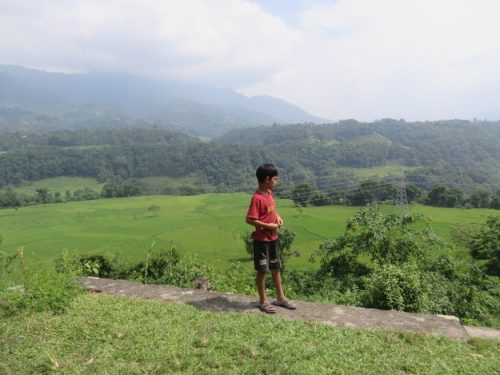By Mandira Singh Shrestha
I was just in time to catch my bus to work. Hurriedly, I stepped onto the bus and found a window seat open. This is a rare occurrence but many of my colleagues were on leave due to the holidays. The FM radio was playing a familiar Nepali tune loud and clear which I hummed along to. Then I heard the radio anchor talk about the one hour load shedding that had taken place that morning. This was big news. It was not a scheduled load shedding but a sudden outage due to a break in the Marsyangdi-Siyuchatar transmission line. All of Kathmandu was affected, but only for one hour. Authorities fixed the problem quickly and we returned to full power. This winter we have been enjoying the luxury of uninterrupted power: this is something we have not experienced in the winter for nearly 15 years.
 Transmission lines in the Nepali countryside, as a boy watches on. PC: Anju Pandit
Transmission lines in the Nepali countryside, as a boy watches on. PC: Anju Pandit
I thought back a year prior, when we endured 16 to 18 hours of load shedding along with the unavailability of gas. Then, one evening around 5:00 pm the electricity came. My whole neighborhood started buzzing with the sounds of the water pumps to fill their tanks. I stepped out to shop for some vegetables. Suddenly, I heard a big bang and saw bright sparks and smoke coming out of a transformer about 20 meters away from where I was standing. The transformer had blown due to the overloading of the system. This was a common happening when we experienced load shedding. The minute one could access power, everyone would come online and blow the transformer and then our cuts would be even longer. Some areas would have no electricity for a few days if the Nepal Electricity Authority (NEA) could not provide a timely repair. It was a challenge to keep ourselves warm. In the midst of winter as the mercury dipped near zero we reverted to using fire wood for cooking and warmth. How fortunate now that we do not experience load shedding in Kathmandu. How has this been possible?
According to the NEA the total installed capacity of hydropower is now 827.376 MW of which 324.446 MW is produced by the independent power producers. Almost all of the installed hydropower projects are run of the river projects, which means that the production of electricity depends on the available flow in the river. During the winter season river flows decrease significantly, thus the electricity generation also reduces and increases the gap between power demand and supply. To address this demand and supply gap, Nepal increases load shedding during the winter.
This winter, however, the scenario is different. NEA is now led by Mr. Kul Man Ghising, and his team has shown us that the load shedding scenario can change. By increasing the efficiency of transmission, reducing transmission losses, importing more power, or adding a surcharge on our electricity tariff, he has shown that Nepal need not suffer load shedding as it has in the past.
A week ago 13 MW from Upper Madi were added to the grid. An additional 40 MW of electricity are being imported from India with total imports now standing at 350 MW. Nepal has signed an agreement with the Power Trade Corporation, India to import a total of 120MW through the Dhalkebar-Muzaffarpur transmission Line from 1 January to 1 May 2017. Ghising has demonstrated that even within the current beauracratic system of NEA, it has been possible to make a change. We are reminded that a well-meaning bureaucrat can make a transformative change by keeping aside the demands of numerous vested interest groups.
However, let us not forget that conserving energy is equally important to increasing its production. It is human nature to be wasteful of that which we have plenty, whether it be electricity, water, or food. Let us all build a culture of conservation. Let us make an extra effort to turn off the light when we leave the room or close the tap when we brush our teeth. Let us change our attitude and build that awareness and sensitize our children to conserve energy.
NEA forecasts that in the next five years the peak demand load will increase from 1,385.30 MW to 2,203.8 MW. To meet the increasing demand of electricity there are several hydropower projects under construction, including the Chamelia, Raughat, Upper Tama Koshi, and Tanahun – for a total of 1,047MW. With the construction of the transmission lines and the implementation of hydropower projects — both run of the river and storage – there is hope to end load shedding throughout the country. With the appropriate policy reforms at the central level to create a conducive environment for hydropower development along with a strong team, good strategy, and political willingnessm, 24/7 electricity in Nepal will be a reality not too far down the road.
